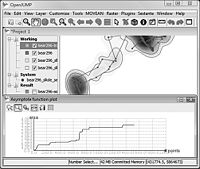Difference between revisions of "Movement Analysis"
(Created page with 'We have create a toolbox for the free GIS software [http://www.openjump.org OpenJUMP] that allows to analyse movement data, called '''OpenJUMP HoRAE'''. The toolbox contains fu…') |
|||
| Line 1: | Line 1: | ||
| − | We have create a toolbox for the free GIS software [http://www.openjump.org OpenJUMP] that allows to analyse movement data, called '''OpenJUMP HoRAE'''. | + | We have create a toolbox for the free GIS software [http://www.openjump.org OpenJUMP] that allows to analyse movement data, called '''OpenJUMP HoRAE'''- '''Ho'''me '''R'''ange '''A'''nalysis and '''E'''stimation. |
| − | The toolbox contains functions for visualization of movement tracks and allows the creation and analysis of animal '' | + | == Background == |
| + | [[image:Figure2_screenshot_asympote_150dpi_grey.jpg|thumb|right|200px|OpenJUMP HoRAE Screenshot]] | ||
| + | The toolbox contains functions for '''visualization''' of movement tracks and allows the creation and '''analysis''' of animal '''home ranges'''. Home range estimation methods that have been implemented are (i) Minimum Convex Polygon (MCP), (ii) Kernel Density Estimation (KDE), (iii) Line-based KDE, (iv) Brownian Bridges, (v) Local Convex Hulls (see the article below). The toolbox was originally developed to analyse location data from grizzly bears (ursus arctos) collected with GPS collars within the Grizzly Bear Programm of the [http://foothillsresearchinstitute.ca/ Foothills Research Institute] (FRI, Alberta, Canada). Funding was provided by [http://www.geoide.ulaval.ca/home.aspx GEOIDE]. | ||
| + | == Download == | ||
* [http://www.geo.uzh.ch/~sstein/ojhorae/openjump132movantools_aug2010.zip download software] (Package including OpenJUMP 1.3.1) | * [http://www.geo.uzh.ch/~sstein/ojhorae/openjump132movantools_aug2010.zip download software] (Package including OpenJUMP 1.3.1) | ||
* [http://www.geo.uzh.ch/~sstein/ojhorae/notes.txt instructions] | * [http://www.geo.uzh.ch/~sstein/ojhorae/notes.txt instructions] | ||
| − | * a short http://www.geo.uzh.ch/~sstein/ojhorae/oj_horae_sstein_v1_wiki.pdf article (pdf)] that describes the functions of the toolbox [http://www.geo.uzh.ch/~sstein/ojhorae/oj_horae_sstein_v1_wiki.pdf - pdf] | + | * a short http://www.geo.uzh.ch/~sstein/ojhorae/oj_horae_sstein_v1_wiki.pdf article (pdf)] that describes the functions of the toolbox [http://www.geo.uzh.ch/~sstein/ojhorae/oj_horae_sstein_v1_wiki.pdf - pdf] (article under submission) |
| + | |||
| + | == Documentation == | ||
We work on a wiki page with some more online documentation. | We work on a wiki page with some more online documentation. | ||
| + | == Contact == | ||
You can contact me, Stefan Steiniger, writing an email to sstein(=at=)geo.uzh.ch. Alternatively you may contact [http://www.ucalgary.ca/~ahunter/ Andrew Hunter]. | You can contact me, Stefan Steiniger, writing an email to sstein(=at=)geo.uzh.ch. Alternatively you may contact [http://www.ucalgary.ca/~ahunter/ Andrew Hunter]. | ||
Revision as of 16:17, 20 October 2010
We have create a toolbox for the free GIS software OpenJUMP that allows to analyse movement data, called OpenJUMP HoRAE- Home Range Analysis and Estimation.
Contents
Background
The toolbox contains functions for visualization of movement tracks and allows the creation and analysis of animal home ranges. Home range estimation methods that have been implemented are (i) Minimum Convex Polygon (MCP), (ii) Kernel Density Estimation (KDE), (iii) Line-based KDE, (iv) Brownian Bridges, (v) Local Convex Hulls (see the article below). The toolbox was originally developed to analyse location data from grizzly bears (ursus arctos) collected with GPS collars within the Grizzly Bear Programm of the Foothills Research Institute (FRI, Alberta, Canada). Funding was provided by GEOIDE.
Download
- download software (Package including OpenJUMP 1.3.1)
- instructions
- a short http://www.geo.uzh.ch/~sstein/ojhorae/oj_horae_sstein_v1_wiki.pdf article (pdf)] that describes the functions of the toolbox - pdf (article under submission)
Documentation
We work on a wiki page with some more online documentation.
Contact
You can contact me, Stefan Steiniger, writing an email to sstein(=at=)geo.uzh.ch. Alternatively you may contact Andrew Hunter.
